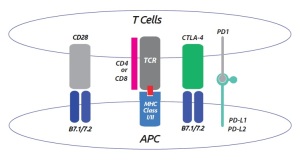In previous blogs, I invited you to join me in exploring the relevance of the following pathways:
Today I’d like to focus on the IDO pathway.
Immune evasion is one of the identifying hallmarks of cancer, and researchers are trying to identify the complex mechanisms that enable cancer cells to evade the host’s immune system. Cancer cells use the indoleamine 2,3-dioxygenase (IDO) pathway to suppress the host’s immune response in order to facilitate survival, growth, invasion, and metastasis of malignant cells. The IDO pathway is active in many tumors, providing a direct defense against T cell attack. The IDO pathway also is active in many antigen-presenting cells, resulting in peripheral tolerance to tumor-associated antigens.
The two IDO isozymes, IDO1 and IDO2, are normally involved in the metabolic breakdown of the amino acid tryptophan. IDO exhibits its immune-dampening effect by suppressing the response of macrophages and effector T cells. The exact mechanism of this immunosuppression is unclear, but it likely involves tryptophan starvation of sensitive T-cells and/or the buildup of toxic metabolites (kynurenines) from tryptophan metabolism, leading to cell cycle arrest and death of effector T cells within the cancer cell microenvironment. IDO expression also directly activates the regulatory T cells that shut down the immune response, which amplifies the suppressive effect.
Inhibitors of the IDO pathway can prevent this immunosuppression and allow the activation of immune cells that recognize and fight the cancer cells. Therefore, IDO is the next hot target behind the PD-1 and CTLA pathways for developing a new class of immunotherapeutic anticancer agents. Importantly, this pathway is a broadly applicable pathway, not specific to any particular form of cancer. IDO inhibition can work in collaboration with chemotherapy and immune-therapeutic drugs and treatments, including strategies using monoclonal antibodies to other immune checkpoint targets such as CTLA-4 or PD-1 and PD-L1.
What’s available for your research/screening activities on the IDO pathway?
Recently, BPS Biosciences have released a number of IDO related products and kits.
- IDO1 protein
- IDO2 protein
- TDO protein (another oxidoreductase enzyme)
- INCB024360 (IDO1 inhibitor)
- NLG919 (IDO1 inhibitor)
- IDO1 Inhibitor Screening Assay Kit
- TDO Inhibitor Screening Assay Kit

The IDO1 Inhibitor Screening Assay Kit is designed to measure IDO1 enzyme inhibition. The kit comes in a convenient format, with enough reaction solution and enzyme to perform a total of 100 reactions. The IDO1 Inhibitor Screening Assay Kit is simple to use. Inhibitor and enzyme are added to a sample containing L-Trp substrate. After a room temperature incubation, activity is determined by measuring the absorption of reaction product at λ =320 – 325 nm (see Figure 1).
Are you interested in this specific ligand or any other of the topics and reagents covered in previous blogs ? Don’t hesitate to get in touch via the form below!




